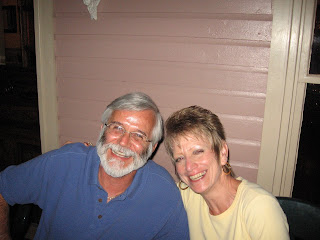We left St. Augustine traveling only 88 miles up I-95 to Woodbine, Georgia near St. Marys. The weather continued to be very hot with highs near 100. That sure restricted what we wanted to do.
Saw this sign as we left Florida. Wait a minute this is not for us any longer as we are no longer just visiting, we will soon be Floridians.
We thought we were under attack from this frog that attached itself to our window. He must have just been checking us out as he was soon gone.
Our stop in St. Marys was to visit Cumberland Island National Seashore. There is a small museum on the mainland that gives the history of the island going back to the first inhabitants, the Timucua culture.
Artifacts of the Timucua people who lived on the mainland and island for more than 4,000 years. They grew crops, hunted and fished to sustain their culture in this area of Georgia and Florida.
Boats on the St. Marys River.
Unless you have a boat, the only way to access Cumberland Island is Cumberland Queen II from St. Marys. The ferry does two trips a day from the mainland and three return trips from the island. You must plan your visit on this schedule as there is no housing for visitors on the island.
On the way to the island you pass the Kings Bay Naval Submarine Base, the home of the Atlantic Fleets nuclear Trident subs.
There are two docks on the south end of the island. Both suffered damage from a hurricane. This one is only used by the park service. The boat on the right is used to transport vehicles and other equipment to the island.
On the day we went to the island it was near 100 so we spent most of our time on the shaded trails and roads in the maritime forest. It was hot but we were not in the direct sun so it was tolerable. The live oak trees here were perfect for building wooden sailing ships, so much of the forest was harvested for that use in the 1800's.
A few fungi along the trail. During the 16th and 17th centuries the island was part of Spanish Florida. Later, the British arrived led by James Oglethorpe who built a hunting lodge called Dungeness along with a fort.
Here is a picture of a couple of wild turkeys that roam the island.
In 1783 Revolutionary War hero Gen. Nathanael Greene was given a land grant on the southern end of the island where he established a plantation. After Nathanael died his wife, Catherine, married Phineas Miller and they built a large mansion called Dungeness. The British recaptured the island during the War of 1812 and freed the slaves. The mansion burned down in 1866.
How about this tree with so many burls?
During the 18th and 19th centuries the north end of the island was mostly small farms and innkeepers. During the Civil War these people fled to the mainland leaving their slaves behind. After the war, those former slaves and their descendants established a couple communities. Many of them worked in the inns that served the rich who visited the island. The only thing that remains of those settlements is the First African Baptist Church where John Kennedy Jr. and Carolyn Bessette were married in 1996.
In the 1880's Pittsburgher Thomas Carnegie, brother of steel magnate Andrew, purchased land on the island to build a winter retreat. In 1884 he and his wife began construction on a 59 room Scottish Castle that was named Dungeness. Thomas did not live to see it completed.
After Thomas died at 43 in 1886, his wife Lucy and her nine children continued to live at Dungeness until the stock market crashed in 1929. The mansion remand empty until 1959 when it burned. These walls are all that remain today.
There are nearly 200 feral horses on the island. Some believe they date back to the early Spanish explorers. Many were domesticated and used by the inhabitants, including the Carnegie's who had carriages on the island. To us they seemed larger than the wild horses we have seen on the Outer Banks, so they are more likely related to the horses left by more recent inhabitants.
These are the remains of the recreation building the Carnegie's had built near the big house. It included a gun and billiard room, a pool, squash court, doctor's office and apartments for visitors. There was also a golf course and 40 other buildings to house the staff of 200.
The magnolia trees were in bloom during our visit.
The Carnegie children built other houses on the island, Plum Orchard in 1898 and Greyfield in 1900. They also owned Stafford Plantation that was there when they purchased the property. Greyfield and Stafford are still privately owned by members of the Carnegie family while Plum Orchard is part of the national seashore and open for tours.
The Greene-Miller Cemetery is the final resting place of Catherine and Phineas and other family members. Robert E. Lee's father, Henry, died here while visiting the island in 1818. He was buried here until his remains were moved to Virginia 100 year later.
The island is 18 miles long and there are very limited options for touring. Tent camping is available at a number of sites for those more adventurous than us. There is water but no food available anywhere on the island. There is a van tour that takes you to Plum Orchard and the First African Baptist Church, but that meant spending most of the day in a van. You can also rent bicycles or hike.
We opted for a 4.5 mile hike. Normally it includes 1.5 miles on the beach but because of the heat and absolutely no wind we hiked to the Dungeness ruins on a trail and then back to the boat on the tree covered main road.
We did go across the dunes to the beach. You have to cross only at one of the few designated paths to help preserve the dunes. They are like the dunes on many of the barrier islands we have been to on the Atlantic coast.
Here we are on the beach all covered up to protect us from the sun and heat. After just a few minutes on the beach we were really happy we had not done the 1.5 mile hike in the sun.
There was no wind and no waves, just this heron fishing in the ocean.
In the 1950's members of the Carnegie family started discussions with the park service about preserving the island in its mostly undeveloped natural state. In 1968 some members of the family sold 3,000 acres to Charles Fraser who had developed Hilton Head. This put in motion a movement by a number of conservation organizations and the family to turn the island into a national seashore that was finalized in 1972.
There are still a few areas under private ownership, but most of those properties are deeded to go to the park service when the owner dies. Hopefully, this amazing piece of natural seashore will never be developed like most of the Atlantic coast barrier islands.






















































